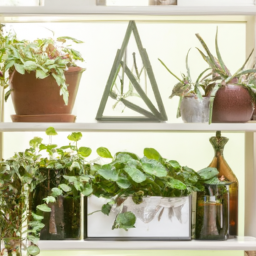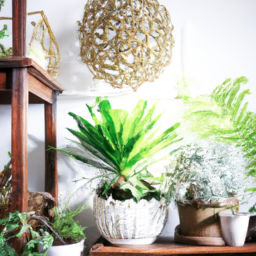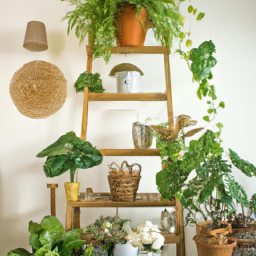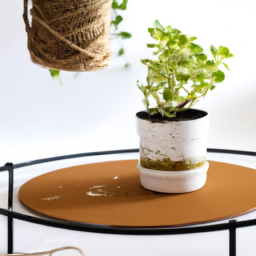
Are you looking to spruce up your plant shelf with some creative and eye-catching displays? Look no further! In this blog post, we will dive into the world of plant shelf styling, where we will explore the art of curating beautiful displays that will transform your space into a botanical oasis. From selecting the perfect plants to arranging them in a visually pleasing manner, we will provide you with all the tips and tricks you need to create stunning plant shelf displays that are sure to impress. So, whether you’re a seasoned plant enthusiast or just starting your green thumb journey, get ready to unleash your creativity and transform your plant shelf into a work of art. Let’s dive into the world of plant shelf styling: curating beautiful displays!
The Art of Plant Shelf Styling: Tips and Tricks for Creating Beautiful Displays
Plant shelf styling is an art that allows you to curate beautiful displays using plants as the main element. Whether you have a small shelf or a large wall unit, incorporating plants into your decor can bring life and freshness to any space. In this guide, we will explore the steps to create stunning plant shelf displays that will make your home feel like a botanical oasis.
Choosing the Right Plants
The first step in plant shelf styling is selecting the right plants for your display. Consider the lighting conditions in the area where your shelf is located. Some plants thrive in bright, indirect light, while others prefer low light conditions. Choose plants that are suitable for the specific light levels in your space.
Additionally, think about the size and shape of the plants. Opt for a variety of heights and textures to add visual interest to your display. Tall plants like snake plants or fiddle leaf figs can provide a striking focal point, while trailing plants like pothos or ivy can add a cascading effect.
Lastly, consider the care requirements of the plants. Select plants that are low-maintenance and easy to care for if you have a busy lifestyle. If you have more time to dedicate to plant care, you can choose more demanding plants that require regular attention.
Arranging the Plants
Once you have chosen the plants, it’s time to arrange them on your shelf. Start by placing the taller plants at the back or in the corners to create depth. This will prevent the display from looking flat and one-dimensional. Place medium-sized plants in the middle, and smaller plants towards the front.
Consider the overall balance and symmetry of the display. Arrange the plants in a way that feels visually pleasing. You can experiment with different heights and groupings to find the perfect arrangement. Don’t be afraid to play around and make adjustments until you achieve the desired look.
Incorporate other decorative elements like vases, books, or sculptures to add interest and personality to your plant display. These items can complement the plants and enhance the overall aesthetic. Just be mindful not to overcrowd the shelf, as it can make the display look cluttered.
Caring for Your Plant Shelf
Now that your plant shelf is beautifully styled, it’s important to care for the plants to ensure they thrive. Regularly check the moisture levels in the soil and water the plants accordingly. Avoid overwatering, as it can lead to root rot and other issues. Each plant has different watering needs, so it’s essential to research and understand the requirements of each species.
Monitor the lighting conditions and adjust the placement of the plants if needed. Some plants may require more or less light depending on their specific needs. Rotate the plants occasionally to ensure even growth and prevent them from leaning towards the light source.
Keep an eye out for pests and diseases. Inspect the plants regularly for any signs of infestation or damage. If you notice any issues, take appropriate measures to address them promptly. This can include using organic pest control methods or seeking professional advice if necessary.
Lastly, don’t forget to dust your plant shelf regularly. Dust can accumulate on the leaves, hindering their ability to photosynthesize. Gently wipe the leaves with a soft cloth or use a plant-friendly leaf shine product to keep them looking vibrant and healthy.
In conclusion, plant shelf styling is a creative and enjoyable way to enhance your home decor. By choosing the right plants, arranging them thoughtfully, and providing proper care, you can create stunning displays that bring life and beauty to any space. So go ahead, unleash your creativity, and transform your shelves into botanical masterpieces!

Curating a Stunning Plant Shelf: Ideas and Inspiration for Styling Greenery in Your Home
Welcome to the world of plant shelf styling, where you can transform your home into a green oasis. Whether you have a small corner or a spacious wall, incorporating plants into your interior design can breathe life into any space. In this guide, we will explore the art of curating beautiful displays on plant shelves, providing you with ideas and inspiration to create your own stunning greenery arrangement.
Choosing the Right Plants
The first step in curating a stunning plant shelf is selecting the right plants. Consider the lighting conditions in your home and choose plants that thrive in those specific environments. Low-light plants such as snake plants and pothos are great for areas with minimal natural light, while succulents and cacti prefer bright, direct sunlight.
When selecting plants, also consider their growth habits and sizes. Opt for a variety of heights and textures to create visual interest. Tall plants like fiddle leaf figs or monstera deliciosas can serve as striking focal points, while trailing plants like ivy or string of pearls can add a cascading effect.
Additionally, think about the care requirements of each plant. If you’re new to plant parenting or have a busy schedule, choose low-maintenance plants that don’t require frequent watering or special attention.
Arranging Your Plant Shelf
Once you have chosen your plants, it’s time to arrange them on your plant shelf. Start by considering the overall aesthetic you want to achieve. Do you prefer a minimalist look with just a few statement plants, or a lush and abundant display?
Begin by placing the taller plants towards the back of the shelf to create depth. This will also ensure that all plants receive adequate light. Then, position medium-sized plants in the middle, and finally, place smaller plants or trailing varieties towards the front to create a layered effect.
Don’t be afraid to experiment with different heights, angles, and groupings. Play around with asymmetry or create a symmetrical arrangement for a more formal look. Remember, there are no strict rules in plant shelf styling – it’s all about finding a layout that pleases your eye.
Adding Decorative Elements
To enhance the visual appeal of your plant shelf, consider adding decorative elements. These can include items such as decorative pots, plant stands, or macrame hangers. Choose containers that complement your overall interior style and color scheme.
Additionally, incorporate other decorative items like artwork, books, or small sculptures to create a curated look. These elements can add personality and depth to your plant shelf, making it a true reflection of your style.
Remember to leave some negative space on your shelf to allow the plants and decorative elements to shine. Overcrowding can make the display look messy and overwhelming.
Lastly, don’t forget to regularly dust and clean your plant shelf to keep it looking fresh and vibrant. Remove any dead leaves or flowers to maintain the overall aesthetic.
With these ideas and inspiration, you are now equipped to curate a stunning plant shelf that will transform your home. Experiment, have fun, and let your creativity flourish as you bring the beauty of greenery indoors. Happy styling!

Plant Shelf Styling: How to Choose the Right Plants and Accessories for a Cohesive Display
Plant shelf styling is a wonderful way to bring life and beauty into your home. By curating a cohesive display of plants and accessories, you can create a visually stunning and inviting space. In this guide, we will explore the steps to choosing the right plants and accessories for a plant shelf display that will leave your guests in awe.
1. Assess Your Space
The first step in plant shelf styling is to assess your space. Take a good look at the area where you plan to display your plants. Consider the size, lighting conditions, and overall aesthetic of the space. This will help you determine the types of plants that will thrive in that environment and the style you want to achieve.
For example, if you have a small shelf in a well-lit room, you may want to opt for smaller plants like succulents or air plants. On the other hand, if you have a large, bright space, you can go for larger plants like fiddle leaf figs or monstera deliciosas.
Additionally, consider the overall style of your home. If you have a minimalist, modern aesthetic, you may want to choose plants and accessories that reflect that style. If your home has a bohemian vibe, you can incorporate more eclectic and colorful elements. Understanding your space and personal style will guide your plant and accessory choices.
2. Choose the Right Plants
Once you have assessed your space, it’s time to choose the right plants for your plant shelf display. There are a few factors to consider when selecting plants:
Lighting: Different plants have different light requirements. Some thrive in bright, direct sunlight, while others prefer indirect or low light conditions. Make sure to choose plants that will thrive in the specific lighting conditions of your space.
Care Level: Consider your level of gardening experience and the amount of time you can dedicate to plant care. Some plants require more attention and care than others. If you’re a beginner or have a busy schedule, opt for low-maintenance plants like snake plants or pothos.
Size and Growth Habit: Take into account the size of your shelf and the growth habit of the plants. You don’t want your plants to outgrow the space or overshadow other plants. Choose plants that will fit well on the shelf and complement each other in terms of size and shape.
Color and Texture: Consider the color and texture of the plants’ leaves. Mixing plants with different leaf colors and textures can create visual interest and add depth to your plant shelf display.
By considering these factors, you can choose a variety of plants that will thrive in your space and complement each other to create a cohesive and visually appealing display.
3. Select Complementary Accessories
Once you have chosen the right plants for your plant shelf display, it’s time to select complementary accessories to enhance the overall aesthetic. Accessories can add personality, texture, and color to your display. Here are some ideas:
Pots and Planters: Choose pots and planters that complement the style of your space and the plants themselves. You can opt for neutral pots to let the plants take center stage or choose colorful pots to add a pop of color. Consider different materials like ceramic, terracotta, or woven baskets for a variety of textures.
Decorative Objects: Incorporate decorative objects like figurines, sculptures, or small pieces of artwork that reflect your personal style. These objects can add visual interest and create a unique focal point within your plant shelf display.
Books and Magazines: Stack books or magazines on your plant shelf to add height and create visual layers. Choose books with beautiful covers or ones that align with your interests to make the display more personal.
Trinkets and Collectibles: Showcase your favorite trinkets or collectibles on your plant shelf. These can be small items like crystals, seashells, or vintage knick-knacks that add a touch of nostalgia and personality.
Remember to arrange your accessories in a way that complements the plants and doesn’t overpower them. Play with different heights, textures, and colors to create a visually balanced and cohesive display.
Plant shelf styling is a creative and enjoyable process that allows you to express your personal style and bring nature indoors. By assessing your space, choosing the right plants, and selecting complementary accessories, you can curate a beautiful and cohesive plant shelf display that will be the envy of all who see it.
Here’s the Summary Snapshot
Are you looking to add a touch of greenery to your home décor? Plant shelves are an excellent way to showcase your favorite plants while adding a stylish element to any room. In this blog post, we will explore the art of plant shelf styling and provide you with tips and inspiration to curate beautiful displays.
When it comes to plant shelf styling, the key is to create a visually appealing arrangement that complements your overall interior design. Start by selecting a variety of plants with different heights, textures, and colors to create depth and interest. Mix and match different types of foliage, such as trailing vines, tall leafy plants, and compact succulents, to add visual diversity to your display. Consider using decorative pots or planters that match your home’s aesthetic, whether it’s modern, bohemian, or minimalist. Don’t be afraid to play with different materials, such as ceramic, terracotta, or woven baskets, to add texture and personality to your plant shelf.
In addition to plants, incorporating other decorative elements can enhance the overall look of your plant display. Add a few carefully curated accessories like small sculptures, candles, or books to create a cohesive and visually pleasing arrangement. Remember to consider the scale and proportion of your accessories to ensure they don’t overpower the plants. Finally, don’t forget about lighting! Place your plant shelf near a window or add some strategic lighting to highlight your beautiful display. With these tips in mind, you’ll be able to create stunning plant shelf displays that will bring life and style to your home.
Here are the top questions that we were asked:
Q1: What is plant shelf styling?
A1: Plant shelf styling refers to the art of arranging and decorating shelves or display areas with various plants, creating visually appealing and curated displays. It involves selecting the right combination of plants, pots, and accessories to achieve a desired aesthetic and enhance the overall ambiance of a space.
Q2: How do I choose the right plants for my plant shelf?
A2: When selecting plants for your plant shelf, consider factors such as lighting conditions, the size of your shelf, and your personal preferences. Opt for plants that thrive in the available light, fit the space without overcrowding, and complement the overall style you want to achieve. Varieties like pothos, succulents, and snake plants are popular choices due to their versatility and low maintenance requirements.
Q3: What are some tips for arranging plants on a shelf?
A3: To create a visually appealing display on your plant shelf, consider the following tips:
– Vary the heights of your plants to add depth and interest.
– Mix and match different leaf shapes, textures, and colors for contrast.
– Use different sizes and styles of pots or containers to add visual variety.
– Consider incorporating trailing plants or climbers to add vertical interest.
– Group plants with similar care requirements together for easier maintenance.
– Add decorative elements like books, artwork, or small sculptures to enhance the overall aesthetic.
Q4: How often should I water my plants on a shelf?
A4: The frequency of watering your plants on a shelf depends on several factors, including the type of plants, the environment, and the season. It’s essential to check the moisture level of the soil regularly. As a general guideline, water your plants when the top inch of soil feels dry. However, it’s crucial to adapt your watering routine according to the specific needs of each plant, as some may require more or less water than others.
Q5: How can I maintain the health of my plant shelf display?
A5: To keep your plant shelf display healthy and vibrant, follow these maintenance tips:
– Regularly dust the leaves to allow for optimal light absorption.
– Monitor the humidity levels in the room and mist your plants if needed.
– Trim or prune your plants as necessary to maintain their shape and size.
– Rotate your plants occasionally to ensure even growth and prevent leaning.
– Keep an eye out for pests and take appropriate action if you notice any infestations.
– Stay informed about the specific care requirements of each plant and provide appropriate fertilization, if necessary.

Lisa Chen is a seasoned indoor gardening expert and the author of several bestselling books on the topic. With a background in horticulture and urban farming, Lisa is dedicated to helping urban dwellers embrace the joys of cultivating green spaces indoors. Her detailed guides and hands-on tips empower readers to transform their living spaces into thriving plant sanctuaries.


